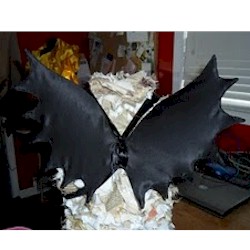Bat Wings

Make these Bat Wings for a super Halloween costume for kids and hours of play time adventure. This craft is meant to be made by a responsible adult because of the materials and tools involved, but is included on our site because of the fun it will provide for the kids.
Supplies
14 Gauge Galvanized WirePliers
Knee High Nylons
Needle
Thread
Permanent Markers
Wire Cutters
Sharpie
Liquid Stitch
Instructions
We've posted pictures to help you follow along with the instructions.
Start off with one big circle made from the 14 gauge wire. Wrap the ends around each other for a firm hold. Use the pliers if you want. I left mind more a a loose wrap because we are about to twist it in another direction.
Twist, and we have a wing shape, or eyeglass shape. Whatever description helps you out. The photo tells it all.
I
measure 11 inches away from the center of our wings. I make a crease with the pliers. I wanted this bend much more severe than the bends in the angle wings. We are going for a more drastic, sharp, evil shape for bat wings.
I grab the wire at 11 inches and twist my hand downward. Keeping a firm grip on the pliers.
This was my bend. I didn't want to crimp it all the way, just in case I change my mind later.
Now I have a straight section I made using the ruler as a guide, and a large curve I have not addressed yet.
I did the same thing with the other wing. When I finished both wings I folded it in half to be sure both wings were symmetrical. This will be important to do every so often as this is a complicated wing shape and it is important to have two wings that are the same.
I measured the length of my loop section, =x. I decided how many swoops I wanted in the wing, =y. I used my simple equation to determine how far apart my bends would be. x/y = space between bends.
Again I use the yard stick to measure the wire. I used a sharpie to mark each bend location before I started making the bends. When I was all marked up I started bending the wire at each mark. I pay no attention to the way the wire bends between the location of my points. Just worry about the points right now.
This is what is looked like after I made the bends with my fingers.
Now I used my fingers to make the curves between bends. I just wanted to bend it so I could crimp the points. I will go back to tweak the curve later.
Each point gets a crimp. This photo shows me using a smooth angled pliers. I tried this first but switched to the tool shown below.
That is my husband's super tool. The pliers in his super tool had ridges in the mouth of the pliers, and I liked the straight shape. It made it easy to hold on to the wire and just clamp down. Nice and tight. The photo shows all my points crimped down.
That didn't look right so I fixed the swoop sections and pulled apart my crimps a bit. It kept the nice tight point but opened up the rest.
Final Shape.
I used a stretch satin. Great fabric, it doesn't have as much stretch as the other fabrics I have been using to cover wings, but I think that is going to be just fine. So for the outside of the wings, lay the fabric down right side, down and pin the frame on top of the fabric. The frame will be laying on top of the wrong side of the fabric.
Cut close to the frame. Give yourself a good inch or 2 so there is plenty of fabric to turn under.
Trim the swoop sections. You will need to snip these swoops like you would for a sleeve, or a neckline. You can see that I have cut a triangle shape at the center of the curve. I tried to fold the fabric over the wire. I could see that did not allow me to hug the wire like I had hoped. So I sniped another cut right down the center of that triangle ( pictured in the above photo).
The three snips seamed to do it for me. Each swoop will require different snips depending on the exact size and shape. Start with the triangle and keep making snips every time you see that the fabric will not hold snugly to the wire. Be sure to snip right up to the base of the wire. The stretch in the fabric will allow you to pull the fabric a bit and hide your snip mark, so get right in there.
When I was all trimmed up as I liked it, I pined the points all down first. By pinning all the points first I am sure to have an even pull through the whole wing. I check the back side to be sure there are no wrinkles, or loose parts. If everything is looking good I can move on.
After managing my points, I fold over the whole top section of the wing. Easy part first.
The most tedious part of the whole project is folding over the swoops and points. So remember you have already folded and pinned the points over. So we have a little start. Start from one end and get to folding. You will need to pin heavily, to keep it nice and tight all the way around.
Something I should also note is that I did both wings together for this project. You can do this same technique with two pieces of fabric, do one wing and than the other. I just happened to have two chunks of this fabric left over from dance costumes. I just used my one large piece to cover both wings.
When you get to the points do not fret. You will lay one side over and trim any extra fabric that goes beyond the frame of the wing. Second side of the point fold over in the same way as the first. do cut off the fabric that extends beyond the frame of the wing.
This is an image to show how the whole back side of the wings are being covered by one large piece of fabric, cut to shape.
We have one side finished now side two. This gets a bit more tricky because we don't have the nice wire to pull the fabric against. I started by laying my 2nd piece of fabric face down on my table. I laid my wings on top of the fabric, and pinned them to each other. I started pinning at the bridge of the wing, and worked my way out. I keep checking on the other side to be sure I am keeping the fabric tight.
When I am all pinned and happy with that, I cut away the extra fabric. You will have to trim this fabric in the same way as the first layer of fabric. This time leave about 1/8 inch between the wire and where the snip begins. We do not have the wire to pull against to hide our snips this time. You will just be folding under the fabric and pinning it to the underside of the wing. So be careful, you will have to re cut the whole thing if you go too deep.
It looks a bit lumpy and bumps with all the pins, but i can see it is reasonably tight. I will pull those wrinkles out when the pins come out and my thread pulls it just that extra 1/8 inch.
All pinned and ready to sew.
Can't stick that 14 gauge wire in my machine. Maybe you have something with a cord foot attachment, but I am not risking that. Also if you use a machine you will not be able to pull it that extra little bit to get it nice and tight. This is best done by hand. It just so happens I love to sew by hand. I find it so relaxing.
I used a nice tight little wip stitch. The best hand sewing is evenly spaced and has consistant tention just like using a machiene. I love the look of my little hand stitches. I makes me think of a lady way back before machienes sewing all her family's cloths by hand. I can't even do that with a machiene. Good for you olden day's Lady.
All done. The bridge isn't perfect but that will be hidden anyway so on we go.
I used 5 yards of 1inch polester ribbon. To make the straps for the wings.
Cut the ribbon in half, so you have two pieces that are 2.5 yards long. I was thinking of myself when I did these wings. The girls like to be the princesses and Mommy is always the witch, or bad guy, so I knew these were ultamatly going to be mine. I have extreamly long arms. I am talking several inches beyond normal, freekish realy. So I didn't think the normal stretch arm bands were right for me. This will tie in the center.
Liquid Stitch the ends. I cut my ends at this nice angle so they would look nice tied in front, you can cut them how ever you like. They will be showing so you want to finish them somehow.
Time to hand sew them into place.
I just wraped the ribbon around the bridge area one time and sewed them in place. I sewed around the outside of each visable ribbon piece. I also sewed accross the ends of the ribbonwhere it leaves the wings and goes off on it's own. Those areas will take a lot of stress so be sure to sew that down well. I am also using a double thread for this center part. The more stable the better. I used a single thread around the wings, because keeping a low profile is more inportant than strength there.
All done. They are so cute on. I am going to have to make a witch costume this year in adult size.
I love the little bow and the backpack configuration. It helps with stability. I was able to forgo some of the bridge because of the backpack style staps on this guy. I am going to have to design the dress to go along with this backpack style strap. Or I can always easly change the straps on this guy.
Editor's Note: Because we could only fit 15 pictures in our instructions, you may want to Click here to see the complete photo instructions.
Contributor

StitchesByJeni is a new blog focusing on highly visual tutorials. This site will discuss how to make all kinds of fiber creations. After graduating from Saint Mary's University of Minnesota with a BA in both Theatre / Speech, and Studio art, Jeni O'Malley worked in home interiors. She specialized in drapery design and fabrication. Becoming a mother of two pretty little princesses (Charlotte age 3, Delilah age 20 months) changed Jeni's life. Now, her inspiration is her children. Combining her fiber arts, costume design, painting, and prop / set construction experiences Jeni manages to sew build and glitter her way through all kinds of projects.





0 thoughts on “Bat Wings”